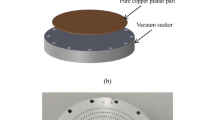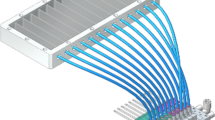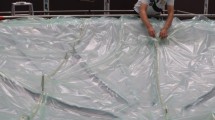Abstract
Based on the theory of small deflection bending of a thin-walled part, a mechanical model of thin-walled planar members under the action of vacuum adsorption was established. Combined with finite-element simulation and testing, the deformation mechanism and law of the thin-walled flat members was studied under the action of vacuum adsorption. Vacuum clamping caused clamping residual stresses on the upper and lower surfaces of the thin-walled flat parts and resulted in torque along the middle surface. When the vacuum clamping was unloaded, the rebound of the thin-walled flat parts that was caused by the torque was the fundamental cause for the clamping deformation. The residual stress and deformation on the surface of the thin-walled flat parts tended to increase and level off with an increase in vacuum. From the initial stage to the stable clamping stage, the radial and tangential stresses in the 200 mm × 2.2 mm workpiece increased by –10 MPa and –27 MPa, respectively, and the relative displacement in the load direction increased by 0.026 mm. Under the effect of vacuum clamping, the maximum deformation capacity of thin-walled flat parts was affected mainly by their initial surface profile error. The stiffness of the workpiece was affected mainly by its thickness; a greater thickness led to a greater stiffness, and a larger vacuum was required for the workpiece to reach a stable clamping state.












Similar content being viewed by others
Data availability
All data generated or analyzed during this study are included in this published article.
References
Wang LY, Huang HH, West RW, Li HJ, Du JT (2018) A model of deformation of thin-wall surface parts during milling machining process. J Cent South Univ 25(5):1107–1115. https://doi.org/10.1007/s11771-018-3810-z
Sim WM (2010) Challenges of residual stress and part distortion in the civil airframe industry. Int J Microstruct Mater Prop 5(4–5):446–455. https://doi.org/10.1504/IJMMP.2010.037621
Li BH, Deng HB, Hui D, Hu Z, Zhang WH (2020) A semi-analytical model for predicting the machining deformation of thin-walled parts considering machining-induced and blank initial residual stress. Int J Adv Manuf Technol 110(5):1–23. https://doi.org/10.1007/s00170-020-05862-1
Fan ZQ, Cao LX, Liu F (2020) FEM analysis of the distortion of thin-walled sealing part affected by the machining-induced residual stress. (eds.) IOP Conference Series: Materials Science and Engineering 768(4):042028. https://doi.org/10.1088/1757-899X/768/4/042028
Cao Y, Shi JL (2016) High speed milling of a large thin sheet copper part with a vacuum fixture on a CNC machine tool. (eds.) Proceedings of the 2nd Annual International Conference on Advanced Material Engineering (AME 2016) 1072–1076. https://doi.org/10.2991/ame-16.2016.173
Ju K, Duan CZ, Kong JX, Chen Y, Sun YW, Wu SL (2020) Prediction of clamping deformation in vacuum fixture–workpiece system for low-rigidity thin-walled precision parts using finite element method. Int J Adv Manuf Technol 109(7):1895–1916. https://doi.org/10.1007/s00170-020-05745-5
He N, Wang ZG, Jiang CY, Zhan B (2003) Finite element method analysis and control stratagem for machining deformation of thin-walled components. J Mater Process Technol 139(1–3):332–336. https://doi.org/10.1016/S0924-0136(03)00550-8
Wu NH, Chan KC, Leong SS (1997) Static interactions of surface contacts in a fixture-workpiece system. Int J Comput Appl Technol 10(3–4):133–151. https://doi.org/10.1504/IJCAT.1997.062244
Qin GH, Wang ZK, Rong YM, Li Q (2017) A unified approach to multi-fixturing layout planning for thin-walled workpiece. Proc IME B J Eng Manufact 231(3):454–469. https://doi.org/10.1177/0954405415585240
Tie GP (2013) Research on the key technology of single point diamond turning for KDP crystal (Doctoral dissertation, National Defense Science and Technology)
Yang JC, Zhang JF, Li J, Xie Q, Feng PF (2019) Optimum design and mechanical analysis for flat fixture of thin-walled wafer workpiece under vacuum adsorption in ultra-precision machining. Journal of Xi'an Jiaotong University 53(04):31–37. https://doi.org/10.7652/xjtuxb201904005
Wang JH, Guo XY, Meng QX, Wang HX, Gu ZQ (2009) Influence on the profile accuracy in diamond turning of KDP crystal in vacuum chuck. Journal of Jiamusi University (Natural Science Edition) 027(001):1–3
Wu SL (2019) Study on vacuum clamping and fly cutting processing deformation of pure copper flat parts (Master's thesis, Dalian University of Technology)
Une A, Kai Y, Mochida M, Matsui S (2001) Flattening ability of a vacuum pin chuck around the periphery of a processed wafer. Microelectron Eng 57:49–57. https://doi.org/10.1016/S0167-9317(01)00428-2
Une A, Ogasawara N, Fukuda T, Yoshise M, Xin P (2009) Influence of a lift hole-equipped pin chuck on wafer flatness. Microelectron Eng 86(4–6):517–520. https://doi.org/10.1016/j.mee.2009.01.079
Une A, Yoshitomi K, Mochida M, Ogasawara N (2009) Influence of pin chuck ring seals and polishing steps on wafer flatness. Microelectron Eng 87(5–8):1646–1649. https://doi.org/10.1016/j.mee.2009.10.020
Yi W (2015) Research on the mechanism of the influence of clamping force on the end milling deformation of thin plate parts and the method of deformation compensation (Doctoral dissertation, Shandong University)
Liu YM (2012) Research on the mechanism of cutting rebound deformation and clamping optimization method for thin plate parts (Doctoral dissertation, Shandong University)
Timoshenko S, Woinowsky-Krieger S (1989) Bending of long rectangular plates to a cylindrical surface. In: Phelps RH (ed) Theory of plates and shells, 2nd edn. McGraw-Hill, New York, pp 1–33
II’gamov MA, Moiseeva VE (2020) Dependence of axisymmetric bending of a circular plate on boundary conditions and pressure on its surface. Lobachevskii Journal of Mathematics 41:1216–1221. https://doi.org/10.1134/S1995080220070197
Funding
This work was supported by the National Natural Science Foundation of China, No. 51805498, and the Key Laboratory of ultra-precision-machining of CAEP, No. ZM18003.
Author information
Authors and Affiliations
Contributions
Design of the work, methodology, and data curation: Yunhua Li; investigation and writing—original draft preparation: Jinxing Kong; conceptualization, review, and editing: Dongxing Du. All authors have read and agreed to the published version of the manuscript.
Corresponding authors
Ethics declarations
Ethics approval
Not applicable.
Consent to participate
All authors have approved to participate.
Consent for publication
The manuscript is approved by all authors for publication.
Competing interests
The authors declare no competing interests.
Additional information
Publisher's note
Springer Nature remains neutral with regard to jurisdictional claims in published maps and institutional affiliations.
Rights and permissions
About this article
Cite this article
Li, Y., Kong, J. & Du, D. Research on deformation mechanism and law of thin-walled flat parts in vacuum clamping. Int J Adv Manuf Technol 118, 2981–2992 (2022). https://doi.org/10.1007/s00170-021-08091-2
Received:
Accepted:
Published:
Issue Date:
DOI: https://doi.org/10.1007/s00170-021-08091-2




